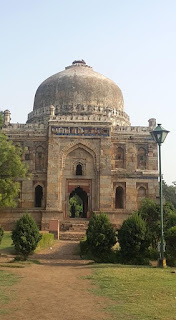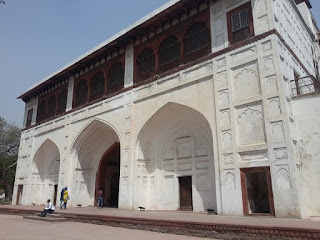Monday, March 9, 2020
Lodhi Gardens and Tombs
Delhi Heritage Trail 19
Lodhi Garden and Tombs
Situated in the heart of Delhi at an 80 acre expanse the Lodhi Gardens is the green heart of Delhi and a place of leisure for the elite Lutyens Delhi. A morning walk in the garden takes you to a different world. The garden they say is home to a myriad of birds including Cuckoos, Black Myna, Woodpecker, Hornbills and House Sparrows. The different sounds made by these birds combine for a early morning Raga to be enjoyed. You can see a group of middle aged Ladies and Gents practising yoga to commands from their master and a lonely old man laughing out loudly and continuously to relieve his stress.
The present Garden was once a village called Khairpur and home to Tombs of the 15th century rulers of Sayyid and Lodi Dynasties of Delhi. They erected beautiful tombs where the Sultans including Mohammed Shah Sayyid (1434-1445) Sikandar Lodi (1489-1517) and a host of their nobles are interred. The present gardens were developed around the Tombs by evicting the villagers of Khairpur in 1936 when New Delhi was being developed during the Governorship of Lord Willingdon. It was again redeveloped in 1968.
Red Fort (Lal Qila)
Delhi Heritage Trail 18
Red Fort (Lal Qila)
This more than 300 year old was built by Shajahan since he wanted to shift the capital from Agra as it was overcrowded. The construction started around 1638 and was completed in the year 1648. Compared to Agra Fort Lal Qila or Red Fort is not that grand. Over a period of time due to invasion of Nadir Shah in 1739 and after the Sepoy Mutiny in 1857 many of the grand buildings inside the Fort were demolished. The British built many barracks in the Fort after demolition of the old buildings after 1857 which are out of place in this heritage site. Only a very few 17th century buildings are left in the Fort like Meena Bazar, Naubat Khana, Diwani-i-Am, Diwani-i-Khas, Rang Mahal, Zafar Mahal, Moti Masjid, Khizri Gate. These buildings are maintained well by the ASI.
Meena Bazaar: This Bazaar was an exclusive retail bazaar which was frequented in 17th and 18th century by the Moghul nobles of the Fort
Naubat Khana : This was also called Drum House were the Musicians of the Fort played whenever there was an occasion or when the King was moving in or out of the Fort
Diwani-i-Am : The hall of public Audience where the King met common people to hear their grievances.
Diwani-i-Khas: The marble hall where the king met the important nobles.
Zafar Mahal : This was built by last Moghul king in 1842 where he used to sit hours together for writing poems.
Moti Masjid : The private masjid of Aurangazeb
Rang Mahal : The place of entertainment.
Khizri Gate : This was the underground gate from Yamuna through which Shajahan entered the Fort in 1648 after its completion for the first time. This is also the gate through which Bahadur Shah Zafar II escaped on 20th September 1857 from the Fort to be caught 3 days later at Humayuns Tomb by Major Hudson.
At James Church Copper Ball
Delhi Heritage Trail 17
The Copper Ball and Cross in St James Church, Kashmere Gate
This Copper Ball and Cross were originally at the top of the central dome of St . James Church, Kashmere Gate. During the Sepoy mutiny of 1857 the church was heavily damaged when the rebels and British had to resort to do or die battle in nearby Kashmere gate. The Copper Ball was severely pierced and damaged by the bullets and after the mutiny they were reconstructed and every effort was made to maintain the original shape. Many of the British Officers and soldiers who lost their lives during mutiny lie buried here including British Commissioner of Delhi at that time Sir William Fraser.
Subscribe to:
Comments (Atom)















